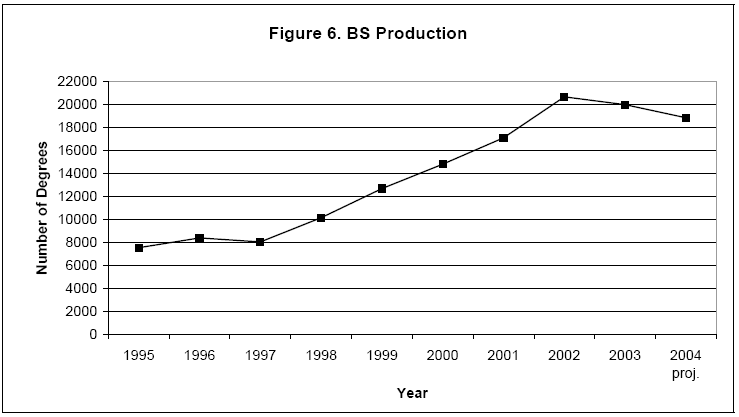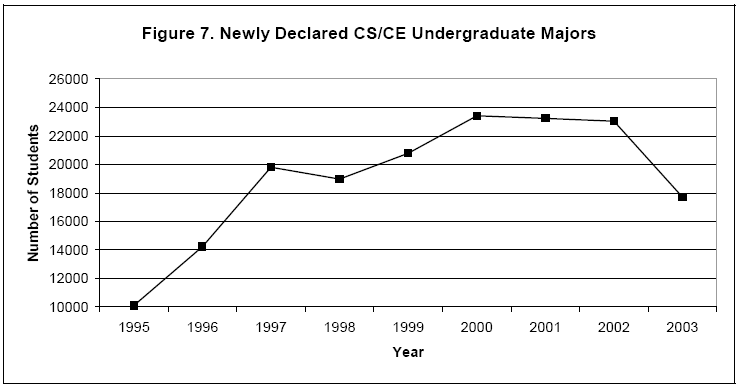THIS IS AN ARCHIVED VERSION OF CRA'S WEBSITE. THIS ARCHIVE IS AVAILABLE TO PROVIDE HISTORICAL CONTENT.
PLEASE VISIT HTTP://WWW.CRA.ORG FOR THE LATEST INFORMATION
| About CRA |
| Membership |
| CRA for Students |
| CRA for Faculty |
| CRA-Women |
| Computing Community Consortium (CCC) |
| Awards |
| Projects |
| Events |
| Jobs |
| Government Affairs |
| Computing Research Policy Blog |
| Publications |
| Data & Resources |
| CRA Bulletin |
| What's New |
| Contact |
| Home |
CRA 2002-2003 Taulbee Survey Results
Below are excerpts from the 2002-2003 Taulbee Survey final results that concern Bachelor's degrees in Computer Science and Computer Engineering (CS/CE). The final results will be published in their entirety in Computing Research News and placed online in May.
Please note: only Ph.D.-granting departments are surveyed, not all degree-granting departments. As a result, the Bachelor’s data reflect trends in the field, not the sum of all enrollments or degrees granted.
For a description of the survey and results from previous years, please visit www.cra.org/statistics/
Excerpts from the 2002-2003 CRA Taulbee Survey Report
“Bachelor's degrees numbered 19,990, a decrease of 3% (following an increase of 21 percent the year before). Most of this decrease came from CE programs; CS production was down less than 2%, perhaps reflecting the residuals of the high growth in undergraduate program enrollment of the late 1990s. Actual Bachelor’s production was only about 1% less than projected last year. Projected Bachelor's production for this year shows a decrease from last year’s projections of 7 percent (see Figure 6).”
“As shown in Figure 7, the number of new undergraduate majors dropped significantly from 23,033 to 17,706 (23%). For the previous three years, the number of new undergraduate students was approximately constant, whereas during the five years before that the number of new undergraduate students more than doubled. One major reason for this striking new trend is that the decline in the technology industry and the moving of jobs offshore is making computer science and engineering less alluring to new undergraduates. In addition, some programs have restricted admission to a subset of those desiring the computer science and engineering major, either by setting numerical limits or increasing the standards for admission. The selectivity of these programs has an impact on the number of students who want to compete for positions in these programs. Lastly, the introduction of new undergraduate programs in the IT field has created alternatives to the traditional CS and CE majors, possibly siphoning students who previously would have selected CS/CE programs. In any case, it is quite clear that the period of explosive growth in enrollments in Bachelor's programs is over.”
“Total enrollments in Bachelor's programs (Table 16) dropped by 19% (having increased in US CS departments by 4%-5% and overall by 11% the previous year)…”



Copyright © 2007 Computing Research Association. All Rights Reserved. Questions? E-mail: webmaster@cra.org.
